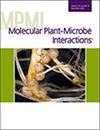求助PDF
{"title":"早期激活的RNAi揭示了葡萄红斑病病毒沉默的目标基因组区域。","authors":"Christian Mandelli, Laurent G Deluc","doi":"10.1094/MPMI-04-25-0038-R","DOIUrl":null,"url":null,"abstract":"<p><p>Grapevine red blotch virus (GRBV), a member of the <i>Geminiviridae</i> family that causes reduced fruit quality and yield, is an emerging challenge for the wine industry. Viticultural practices and pest management have been largely ineffective at mitigating the impacts of GRBV, necessitating alternative control strategies. Here, we investigated the early activation of RNA interference (RNAi) in GRBV-infected grapevines and, through small RNA sequencing, identified nine genomic virus-derived small-interfering RNA (vsiRNA)-producing regions referred to as hotspots (HSs). Subsequent analyses revealed that these HSs were primarily involved in producing 24-nt vsiRNA species associated with transcriptional gene silencing toward later stages of infection. Double-stranded RNA molecules derived from these HSs were administered to GRBV-infected plants via root soaking, significantly (<i>P</i> < 0.05) reducing viral gene expression in leaves and petioles for up to 1 month. Ultimately, we assessed the potential of viral mutation within these HSs, identified areas of higher mutational entropy, and found that most HS locations are within viral regions with lower probabilities of mutation events. These findings provide the basis for future research to characterize the role of small RNA-induced silencing mechanisms in grapevine-GRBV interactions and their potential translation for field-based technology, such as RNAi biopesticides, to manage red blotch disease. [Formula: see text] Copyright © 2025 The Author(s). This is an open access article distributed under the CC BY-NC-ND 4.0 International license.</p>","PeriodicalId":19009,"journal":{"name":"Molecular Plant-microbe Interactions","volume":" ","pages":"MPMI04250038R"},"PeriodicalIF":3.4000,"publicationDate":"2025-09-23","publicationTypes":"Journal Article","fieldsOfStudy":null,"isOpenAccess":false,"openAccessPdf":"","citationCount":"0","resultStr":"{\"title\":\"Early Activation of RNAi Reveals Genomic Regions of Grapevine Red Blotch Virus Targeted for Silencing in Grapevine.\",\"authors\":\"Christian Mandelli, Laurent G Deluc\",\"doi\":\"10.1094/MPMI-04-25-0038-R\",\"DOIUrl\":null,\"url\":null,\"abstract\":\"<p><p>Grapevine red blotch virus (GRBV), a member of the <i>Geminiviridae</i> family that causes reduced fruit quality and yield, is an emerging challenge for the wine industry. Viticultural practices and pest management have been largely ineffective at mitigating the impacts of GRBV, necessitating alternative control strategies. Here, we investigated the early activation of RNA interference (RNAi) in GRBV-infected grapevines and, through small RNA sequencing, identified nine genomic virus-derived small-interfering RNA (vsiRNA)-producing regions referred to as hotspots (HSs). Subsequent analyses revealed that these HSs were primarily involved in producing 24-nt vsiRNA species associated with transcriptional gene silencing toward later stages of infection. Double-stranded RNA molecules derived from these HSs were administered to GRBV-infected plants via root soaking, significantly (<i>P</i> < 0.05) reducing viral gene expression in leaves and petioles for up to 1 month. Ultimately, we assessed the potential of viral mutation within these HSs, identified areas of higher mutational entropy, and found that most HS locations are within viral regions with lower probabilities of mutation events. These findings provide the basis for future research to characterize the role of small RNA-induced silencing mechanisms in grapevine-GRBV interactions and their potential translation for field-based technology, such as RNAi biopesticides, to manage red blotch disease. [Formula: see text] Copyright © 2025 The Author(s). This is an open access article distributed under the CC BY-NC-ND 4.0 International license.</p>\",\"PeriodicalId\":19009,\"journal\":{\"name\":\"Molecular Plant-microbe Interactions\",\"volume\":\" \",\"pages\":\"MPMI04250038R\"},\"PeriodicalIF\":3.4000,\"publicationDate\":\"2025-09-23\",\"publicationTypes\":\"Journal Article\",\"fieldsOfStudy\":null,\"isOpenAccess\":false,\"openAccessPdf\":\"\",\"citationCount\":\"0\",\"resultStr\":null,\"platform\":\"Semanticscholar\",\"paperid\":null,\"PeriodicalName\":\"Molecular Plant-microbe Interactions\",\"FirstCategoryId\":\"99\",\"ListUrlMain\":\"https://doi.org/10.1094/MPMI-04-25-0038-R\",\"RegionNum\":3,\"RegionCategory\":\"生物学\",\"ArticlePicture\":[],\"TitleCN\":null,\"AbstractTextCN\":null,\"PMCID\":null,\"EPubDate\":\"\",\"PubModel\":\"\",\"JCR\":\"Q2\",\"JCRName\":\"BIOCHEMISTRY & MOLECULAR BIOLOGY\",\"Score\":null,\"Total\":0}","platform":"Semanticscholar","paperid":null,"PeriodicalName":"Molecular Plant-microbe Interactions","FirstCategoryId":"99","ListUrlMain":"https://doi.org/10.1094/MPMI-04-25-0038-R","RegionNum":3,"RegionCategory":"生物学","ArticlePicture":[],"TitleCN":null,"AbstractTextCN":null,"PMCID":null,"EPubDate":"","PubModel":"","JCR":"Q2","JCRName":"BIOCHEMISTRY & MOLECULAR BIOLOGY","Score":null,"Total":0}
引用次数: 0
引用
批量引用

 求助内容:
求助内容: 应助结果提醒方式:
应助结果提醒方式:


